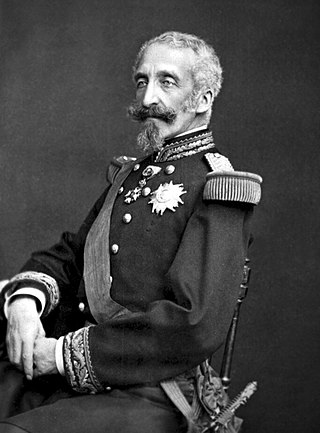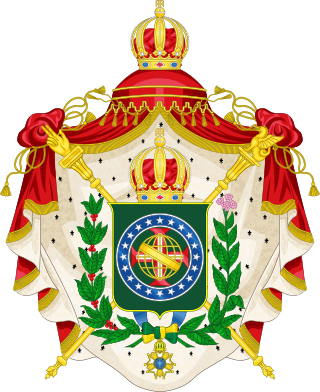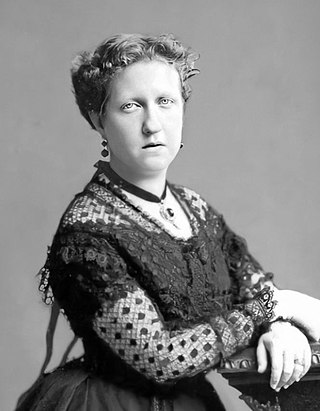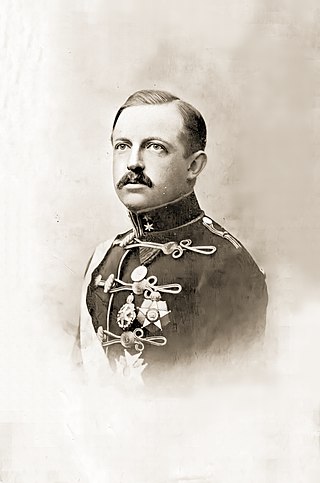
Prince Louis of Orléans, Duke of Nemours was the second son of King Louis-Philippe I of France, and his wife Maria Amalia of Naples and Sicily.

The Most Serene House of Braganza, also known as the Brigantine dynasty, is a dynasty of emperors, kings, princes, and dukes of Portuguese origin which reigned in Europe and the Americas.

Isabelle of Orléans-Braganza was the consort of the Orléanist pretender to the French throne, Henri, Count of Paris, and the daughter of Pedro de Alcântara, Prince of Grão-Pará, pretender to the throne of the Empire of Brazil.

The 4th House of Orléans, sometimes called the House of Bourbon-Orléans to distinguish it, is the fourth holder of a surname previously used by several branches of the Royal House of France, all descended in the legitimate male line from the dynasty's founder, Hugh Capet. The house was founded by Philippe I, Duke of Orléans, younger son of Louis XIII and younger brother of Louis XIV, the "Sun King".

The Imperial House of Brazil is a Brazilian dynasty of Portuguese origin, a branch of the House of Braganza, that ruled the Brazilian Empire from 1822 to 1889, from the time when the then Prince Royal Dom Pedro of Braganza declared Brazil's independence, until Dom Pedro II was deposed during the military coup that led to the Proclamation of the Republic in 1889.

The Head of the Brazilian Imperial House is a title used by the leader of the Brazilian imperial family, currently the House of Orléans-Braganza, a descendant branch of the House of Braganza. The title of the head of the imperial house is "Emperor de jure". The current head of the imperial house is Prince Bertrand of Orléans-Braganza, who took over as head of the imperial house on July 15, 2022, after the death of his brother, Prince Luiz of Orléans-Braganza.

DonaIsabel, nicknamed "the Redemptress", was the Princess Imperial of the Empire of Brazil and the Empire's regent on three occasions. Born in Rio de Janeiro as the eldest daughter of Emperor Pedro II of Brazil and Empress Teresa Cristina, she was a member of the Brazilian branch of the House of Braganza. After the deaths of her two brothers in infancy, she was recognized as her father's heiress presumptive. She married a French prince, Gaston, Count of Eu, in an arranged marriage and they had three sons.

Prince Gaston of Orleans, Count of Eu was a French prince and military commander who fought in the Hispano-Moroccan War and the Paraguayan War. He was the first son of Louis, Duke of Nemours and Princess Victoria of Saxe-Coburg and Gotha, and was married to Princess Isabel, daughter of Pedro II of Brazil and heiress to the Brazilian throne.

Prince Ludwig August of Saxe-Coburg and Gotha, known in Brazil as Dom Luís Augusto, was a German prince of the House of Saxe-Coburg and Gotha-Koháry and an Admiral in the Imperial Brazilian Navy.

DomPedro de Alcântara of Orléans-Braganza, Prince of Grão Pará was the first-born son of Dona Isabel, Princess Imperial of Brazil and Prince Gaston of Orléans, Count of Eu, and as such, was born second-in-line to the imperial throne of Brazil, during the reign of his grandfather, Emperor Dom Pedro II, until the empire's abolition. He went into exile in Europe with his mother when his grandfather was deposed in 1889, and grew up largely in France, at a family apartment in Boulogne-sur-Seine, and at his father's castle, the Château d'Eu in Normandy.

Princess Leopoldina of Brazil was the daughter of Emperor Pedro II and Empress Teresa Cristina. She shared the first name of her grandmother, Empress Maria Leopoldina of Brazil.

The Old Cathedral of Rio de Janeiro dedicated to Our Lady of Mount Carmel is an old Carmelite church which served as cathedral (Sé) of Rio de Janeiro from around 1808 until 1976. During the 19th century, it was also used successively as Royal and Imperial Chapel by the Portuguese Royal Family and the Brazilian Imperial Family, respectively. It is located in the Praça XV square, in downtown Rio. It is one of the most important historical buildings in the city.

The House of Orléans-Braganza is by legitimacy, the imperial house of Brazil formed in 1864, with the marriage of the heir to the Brazilian throne, Isabel of Braganza with Prince Gaston, Count of Eu. The House of Orléans-Braganza never reigned, as Brazil's pure Braganza monarch, Emperor Pedro II being deposed in a military coup d'état, under the pressure of the civilian republicans, in 1889. However, with the death of Isabel in 1921, as the last Brazilian pure Braganza, her descendants inherited the dynastic rights of the Brigantine dynasty over the defunct Brazilian throne.

The Imperial Order of the Rose was a Brazilian order of chivalry, instituted by Emperor Pedro I of Brazil on 17 October 1829 to commemorate his marriage to Amélie of Leuchtenberg.

Prince Luís of Orléans-Braganza, nicknamed "the Perfect Prince", was the second son of Isabel, Princess Imperial of Brazil and Prince Gaston, Count of Eu, and patriarch of the Vassouras branch of the House of Orléans-Braganza. His grandfather, Pedro II of Brazil, was the last emperor of Brazil.

DonaMaria Francisca was the daughter of Pedro de Alcântara, Prince of Grão-Pará, head of the Petrópolis line of the House of Orléans-Braganza. She married Duarte Nuno, Duke of Braganza, pretender to the Portuguese throne, with whom she had three sons, the eldest of whom, Duarte Pio, is the current pretender.

The Palace of the Grand Pará is a royal palace located in the city of Petrópolis, in the state of Rio de Janeiro, Brazil. It is currently the only palace still belonging to the Brazilian Imperial Family, being the only royal palace in the Americas occupied by a royal family.

The Pantheon of the House of Braganza, also known as the Pantheon of the Braganzas, is the final resting place for many of the members of the House of Braganza, located in the Monastery of São Vicente de Fora in the Alfama district of Lisbon, Portugal. The pantheon's burials have included Portuguese monarchs, Brazilian monarchs, a Romanian monarch, queen consorts of Portugal, and notable Infantes of Portugal, among others.

Prince of Orléans-Bragança is a noble title informally attributed to all direct and legitimate agnatic descendants of Louis Philippe Gaston de Orléans, count d'Eu and Imperial Prince Consort of Brazil, as consort of the last Imperial Princess of Brazil, Isabel of Braganza.




















